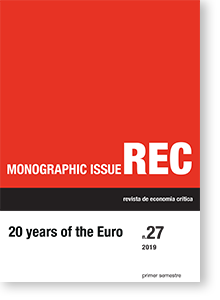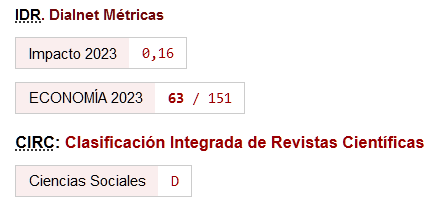Beyond the Euro: limits to economic policy in the EU
Palabras clave:
E6, F45Resumen
The euro’s crisis is often theorized as that of a fixed exchange-rate monetary system, whose rigidity in the face of heterogenous national economies is the main factor behind the Eurozone's troubles. We argue instead that the euro should be primarily considered as a successful attempt to further the integration of the European economy within an ordoliberal framework, part of an institutional continuum stretching from the European Single Market to the present. Further, we note that the constraints placed by the euro on national economies are deeply entangled with those deriving from EU membership, so that both are likely to weigh on any attempt to break with neoliberalism at national level.
Descargas
Citas
Akman, P.; Kassim, H. (2010): "Myth and Myth-Making in the European Union: The Institutionalization and Interpretation of EU Competition Policy", Journal of Common Market Studies, 48, pp. 111-132.
https://doi.org/10.1111/j.1468-5965.2009.02044.x
Almunia, J., (2009): A Challenging Anniversary: The Euro at Ten and the Financial Crisis. In J. Pisani-Ferry and A. S. Posen, eds. The Euro at Ten: the Next Global Currency? Washington D.C.: Peterson Institute for International Economics, pp. 17-22.
Anderson et al. (2018): Competition policy, trade and the global economy: existing WTO elements, commitments in regional trade agreements, current challenges and issues for reflection, Staff Working Paper ERSD-2018-12, World Trade Organization.
https://doi.org/10.2139/ssrn.3321116
Baldwin, R. and Giavazzi, F. eds., (2015): The Eurozone Crisis A Consensus View of the Causes and a Few Possible Solutions. A VoxEU.org eBook, London: CEPR Press. Available at: https://voxeu.org/sites/default/files/file/reboot_upload_0.pdf.
Bellofiore, R., Garibaldo, F. and Halevi, J., (2011): The Global Crisis and the Crisis of European Neomercantilism. Socialist Register, 47, pp. 120-146.
Bellofiore, R.; Garibaldo, F.; Mortagua, M., (2015): A credit-money and structural perspective on the European crisis: why exiting the euro is the answer to the wrong question. Review of Keynesian Economics, 3(4), pp.471-490.
https://doi.org/10.4337/roke.2015.04.03
Beukers, Th., 2013. The new ECB and its relationship with the Eurozone Member States: between central bank independence and central bank intervention. Common Market Law Review, 50, pp.1579-1620.
https://doi.org/10.54648/COLA2013160
Blyth, M., (2010): Austerity: The History of a Dangerous Idea, Oxford University Press.
Bonefeld, W, (2016): "Authoritarian Liberalism: From Schmitt via Ordoliberalism to the Euro". Critical Sociology, pp. 1-15.
Braun, B., (2017): Two sides of the same coin? Independence and Accountability of the European Central Bank, Available at: http://transparency.eu/ecb/.
Buch-Hansen, H. and Wigger, A., (2010): Revisiting 50 years of market-making: the neo-liberal transformation of European competition policy. Review of International Political Economy, 17(1), pp. 20-44.
https://doi.org/10.1080/09692290903014927
Calmfors, L. et al., (2012): Chapter 2: The European Balance-of-Payments Problem. In EEAG Report on the European Economy 2012. Munich: CESifo Group, pp. 57-82.
Celi, G., Ginzburg, A., Guarascio, D. and Simonazzi, A., (2018): Crisis in the European Monetary Union: A Core-Periphery Perspective, London: Routledge.
https://doi.org/10.4324/9781315542966
Cesaratto, S.; Stirati, A., (2010): Germany and the European and Global Crises. International Journal of Political Economy, 39(4), pp. 56-86.
https://doi.org/10.2753/IJP0891-1916390403
Cesaratto, S., (2013): The implications of TARGET2 in the European balance of payments crisis and beyond. European Journal of Economics and Economic Policies: Intervention, 10, pp. 359-382.
https://doi.org/10.4337/ejeep.2013.03.09
Cesaratto, S., (2015): Balance of Payments or Monetary Sovereignty? In Search of the EMU's Original Sin. International Journal of Political Economy, 44(2), pp. 142-156.
https://doi.org/10.1080/08911916.2015.1060830
Cesaratto, S., (2017): Alternative interpretations of a stateless currency crisis. Cambridge Journal of Economics, 41(4), pp. 977-998.
https://doi.org/10.1093/cje/bew065
Cesaratto, S., (2018): The nature of the eurocrisis. A reply to Febrero, Uxò and Bermejo. Review of Keynesian Economics, 6(2), pp. 240-251.
https://doi.org/10.4337/roke.2018.02.05
Chardonnet, A.; Langerock, J., (2017): Black list or whitewash? What a real EU blacklist of tax havens should look like. Oxfam Briefing Note.
https://doi.org/10.21201/2017.1251
Dardot, P.; Laval, C. (2009): La nouvelle raison du monde: Essai sur la société néolibérale,. La Découverte/Poche.
https://doi.org/10.3917/dec.dardo.2010.01
De Grauwe, P.; Ji, Y., (2013): Panic-driven austerity in the Eurozone and its implications. Voxeu.org. Available at: https://voxeu.org/article/panic-driven-austerity-eurozone-and-its-implications.
Eichengreen, B. (1996): La Globalización del Capital: Historia del Sistema Monetario Internacional, Antoni Bosch editor.
Eichengreen, B., (2008): The real exchange rate and economic growth (English). Commission on growth and development working paper; no. 4. Washington, DC: World Bank. Available at: http://documents.worldbank.org/curated/en/868701468152077108/The-real-exchange-rate-and-economic-growth.
Eichengreen, B., Jung, N., Moch, S., Mody, A. et al., (2014): The Eurozone Crisis: Phoenix Miracle or Lost Decade? Journal of Macroeconomics, 39, pp. 288-308.
https://doi.org/10.1016/j.jmacro.2013.08.005
Fazi, T.; Mitchell, W. (2017): Reclaiming the State: A Progressive Vision of Sovereignty for a Post-Neoliberal World, Pluto Press.
https://doi.org/10.2307/j.ctt1v2xvvp
Febrero, E.; Uxó, J.; Bermejo, F., (2018): The financial crisis in the eurozone: a balance-of-payments crisis with a single currency? Review of Keynesian Economics, 6(2), pp. 221-239. Available at: https://www.elgaronline.com/view/journals/roke/6-2/roke.2018.02.04.xml.
https://doi.org/10.4337/roke.2018.02.04
Febrero, E.; Uxó, J.; Dejuán, Ó., (2015): The ECB During the Financial Crisis. Not so Unconventional! Metroeconomica, 66(4), pp. 715-739.
https://doi.org/10.1111/meca.12088
Felipe, J.; Kumar, U., (2014): Unit labor costs in the Eurozone: the competitiveness debate again. Review of Keynesian Economics, 2, pp. 490-507.
https://doi.org/10.4337/roke.2014.04.07
Flassbeck, H. and Lapavitsas, C., (2015): Against the Troika: Crisis and Austerity in the Eurozone, London: Verso.
Frenkel, R., (2014): What Have the Crises in Emerging Markets and the Euro Zone in Common and What Differentiates Them? In J. E. Stiglitz and D. Heymann, eds. Life After Debt: The Origins and Resolutions of Debt Crisis. London: Palgrave Macmillan UK, pp. 122-141.
https://doi.org/10.1057/9781137411488_6
Gill, S. (1998): European governance and new constitutionalism: Economic and Monetary Union and alternatives to disciplinary Neoliberalism in Europe, New Political Economy, 3(1), pp. 5-26
https://doi.org/10.1080/13563469808406330
Glyn, A (ed.) (2001): Social Democracy in Neoliberal Times: The Left and Economic Policy Since 1980, Oxford University Press.
https://doi.org/10.1093/acprof:oso/9780199241378.001.0001
Goodhart, C. and Lastra, R. (2017): Populism and central bank independence. Open Economies Review. DOI: 10.1007/s11079-017-9447-y.
https://doi.org/10.1007/s11079-017-9447-y
Hall, P.A., (2018): Varieties of capitalism in light of the euro crisis. Journal of European Public Policy, 25(1), pp. 7-30.
https://doi.org/10.1080/13501763.2017.1310278
Juncker, J.C., (2015): Preparing for Next Steps on Better Economic Governance in the Euro Area: Analytical Note, Informal European Council, 12 February. Available at: https://ec.europa.eu/commission/sites/betapolitical/files/analytical_note_en.pdf.
Krugman, P., (2013): Revenge of the Optimum Currency Area. In D. Acemoglu, J. Parker, and M. Woodford, eds. NBER Macroeconomics Annual 2012, Volume 27. Chicago: University of Chicago Press, pp. 439-448.
https://doi.org/10.1086/669188
Krugman, P.; Taylor, L., (1978): Contractionary effects of devaluation, Journal of International Economics, 8(3), pp. 445-456.
https://doi.org/10.1016/0022-1996(78)90007-7
Lapavitsas, C., (2019): The Left Case Against the EU, Cambridge: Polity Press.
Lavoie, M., (2015a): The Eurozone: Similitudes and differences with Keynes's Plan. International Journal of Political Economy, 4, pp. 3-17.
https://doi.org/10.1080/08911916.2015.1035980
Lavoie, M., (2015b): The Eurozone Crisis: A Balance-of-Payments Problem or a Crisis Due to a Flawed Monetary Design? International Journal of Political Economy, 44(2), pp. 157-160.
https://doi.org/10.1080/08911916.2015.1060831
Mazier, J.; Petit, P., (2013): In search of sustainable paths for the eurozone in the troubled post-2008 world. Cambridge Journal of Economics, 37(3), pp. 513-532.
https://doi.org/10.1093/cje/bet012
Nouira, R.; Sekkat, K., (2012): Desparately seeking the positive impact of undervaluation on growth, Journal of Macroeconomics, 34(2), pp. 537-552.
https://doi.org/10.1016/j.jmacro.2011.12.002
O'Connell, A., (2016): The Eurozone "Debt" Crisis: Another "Center" - "Periphery" Crisis Under Financial Globalization?, Ineteconomics Working Papers, No. 51.
https://doi.org/10.2139/ssrn.2877979
Padoa-Schioppa, T. (1994): The Road to Monetary Union in Europe: The Emperor, the Kings, and the Genies. Oxford: Clarendon Press.
Pisani-Ferry, J.; Posen, A.S., (2009): Introduction. The Euro at 10-Successful, but Regional. In J. Pisani-Ferry and A. S. Posen, eds. The Euro at Ten: The Next Global Currency? Washington D.C.: Peterson Institute for International Economics, pp. 1-15.
Portella-Carbó, F., (2015): Mass unemployment in Spain (1959-2014): productive and commercial problems of a peripheral economy in global capitalism. University of Girona. Available at: http://dugi-doc.udg.edu/handle/10256/12237.
Portella-Carbó, F., (2017): El paro de masas en España ( 1959-2014 ): la estructura productiva en la integración al capitalismo global. Revista de Historia Industrial, 67, pp.125-157.
Portella-Carbó, F., Dejuán, Ó., forthcoming. Trade Imbalances and Fiscal Policy in the Eurozone: An Analysis of Economic Interrelations with a Global Supermultiplier Input-Output Model, Cambridge Journal of Economics, https://doi.org/10.1093/cje/bey011
https://doi.org/10.1093/cje/bey011
Schäuble, W., 2011. "Why Austerity Is the Only Cure for the Eurozone", Financial Times, 5th September.
Schröder, E., 2015. Eurozone imbalances: Measuring the contribution of expenditure switching and expenditure volumes 1990-2013. The New School for Social Research, Working Paper 08/2015.
Seccareccia, M., (2017): Is high employment in the eurozone possible? Some reflections on the institutional structure of the eurozone and its crisis. European Journal of Economics and Economic Policies. Intervention, 14(3), pp.351-371.
https://doi.org/10.4337/ejeep.2017.03.06
Simonazzi, A., Ginzburg, A. and Nocella, G., 2013. Economic relations between Germany and southern Europe. Cambridge Journal of Economics, 37(3), pp. 653-675.
https://doi.org/10.1093/cje/bet010
Sinn, H., (2014): Austerity, Growth and Inflation: Remarks on the Eurozone's Unresolved Competitiveness Problem. The World Economy, 37(1), pp. 1-13.
https://doi.org/10.1111/twec.12130
Stehrer, R. and Stöllinger, R., (2015): The Central European Manufacturing Core: What is driving regional production sharing?, FIW-Research Reports 2014/15 N° 02.
Stiglitz, J.E., (2016): The Euro: How a Common Currency Threatens the Future of Europe, New York: W.W. Norton and Company.
Stockhammer, E., 2015. Rising inequality as a cause of the present crisis. Cambridge Journal of Economics, 39(3), pp. 935-958.
https://doi.org/10.1093/cje/bet052
Storey, A. (2017): The Myths of Ordoliberalism Working Paper 17-02, ERC Project "European Unions", University College Dublin. Available at: www.erc-europeanunions.eu/working-papers.
Storm, S.; Naastepad, C.W.M., (2015): Crisis and Recovery in the German Economy: The Real Lessons. Structural Change and Economic Dynamics, 32, pp. 11-24.
https://doi.org/10.1016/j.strueco.2015.01.001
Storm, S.; Naastepad, C.W.M., (2015): "Europe's hunger games: Income distribution, cost competitiveness and crisis". Cambridge Journal of Economics, 39(3), pp. 959-986.
https://doi.org/10.1093/cje/beu037
Storm, S.; Naastepad, C.W.M., (2016): Myths, Mix-ups and Mishandlings: Understanding the Eurozone Crisis. International Journal of Political Economy, 45(1), pp. 46-71.
https://doi.org/10.1080/08911916.2016.1159084
Syrovatka, F.; Schneider, E.; Sabkowski, T., (2018): Ten Years of Crisis. European economic integration between silent revolution and breakup. Analysen, 53, Rosa-Luxemburg-Stiftung.
Thirlwall, A.P., (2011): The Balance-of-Payments constraint as an explanation of International Growth Differences. PSL Quarterly Review, 64(259), pp. 429-438.
Trichet, J.C., (2010): Lessons from the Crisis, Speech by Jean-Claude Trichet, President of the ECB at the European American Press Club, Paris, 3rd December.
Trichet, J.C.; Fernández Ordoñez, M., (2011): Letter from the ECB president J-C. Trichet and BdE president M.A. Fernández Ordoñez to the Spanish Prime Minister J.L. Rodríguez Zapatero on the 5th of August 2011. Available at: https://www.ecb.europa.eu/ecb/access_to_documents/document/correspondence/shared/data/ecb.dr.cor20110805Zapatero.en.pdf
Trichet, J.C.; Draghi, M., (2011): C'è l'esigenza di misure significative per accrescere il potenziale di crescita. Corriere de la Sera, 5th August.
Wood, E. M. (2006): Logics of Power: A conversation with David Harvey. Historical Materialism, 14(4), pp. 9-34.
https://doi.org/10.1163/156920606778982527
Wyplosz, C., (2013): The Eurozone Crisis and the Competitiveness Legend. Asian Economic Papers, 12(3), pp. 63-81.
https://doi.org/10.1162/ASEP_a_00238
Wyplosz, C., (2016): The six flaws of the Eurozone. Economic Policy, 31(87), pp. 559-606.
Descargas
Publicado
Cómo citar
Número
Sección
Licencia
Esta licencia permite a terceros compartir (copiar y redistribuir el material en cualquier medio o formato) y adaptar (remezclar, transformar y crear a partir del material para cualquier finalidad, incluso comercial), siempre que se reconozca la autoría y la primera publicación en esta revista (La Revista, DOI de la obra), se proporcione un enlace a la licencia y se indique si se han realizado cambios en la obra.







